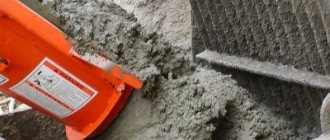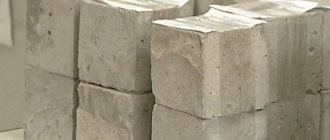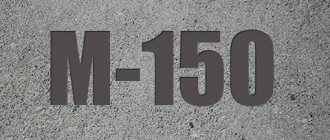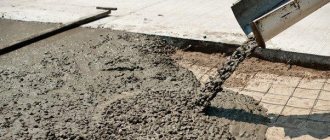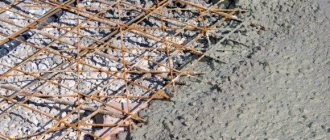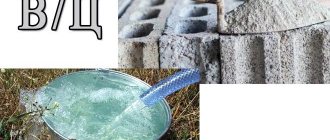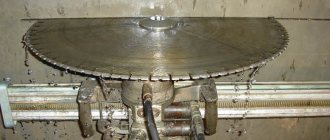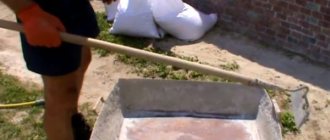Concrete is one of the most popular building materials; it has a wide range of characteristics that determine its quality and installation features. These include the mobility of the concrete mixture, indicating the fluidity of concrete - a property that is important for proper work with it. This characteristic affects the strength and durability of the structure, therefore it is indicated in the technical documentation.
What is the workability of concrete?
Mobility is the ability of concrete to be plastic and shrink. Simply put, the more liquid there is in the concrete dough, the thinner the solution looks, the more mobile it is. Mobile solutions are easy to pour into frequent fittings, complex cracks or limited spaces. Plastic concrete is easy to form and manufacture.
The logical question is: if plastic concrete is so good, then why isn’t it used all the time? Here, as in any industry, there is nothing absolutely ideal. The fact is that the amount of water, which mainly determines mobility, reduces strength. Normal concrete dough after petrification is always stronger than plastic and easy-to-place “milk”. Therefore, in each specific case, builders solve the problem of choosing a concrete solution, choosing the golden mean and ideal proportions for each specific case.
It will not be possible to lay fixed concrete well on a large amount of reinforcement. By the way, absolutely motionless concrete is used extremely rarely, as it requires a lot of effort and specialized equipment for installation. In the history of construction, very few buildings are known in the construction of which fixed concrete was used. At the moment there are only a few such structures.
The essence of the method for determining mobility with a cone
The method is based on the use of a truncated cone about 30 cm high (capacity no more than 6 liters), as well as the understanding that mobility is interconnected with the presence of liquid in the mixture. It is important to take into account the presence of plasticizers and their quantity per 1 cubic meter. This procedure is carried out in the following order:
- the cone is filled with solution
- concrete is pierced (bayoneted) to compact and remove voids, supplemented with mixture
- the cone is removed (lifted vertically) and placed next to the solution
- plasticity is checked:
- if the settlement of the concrete cone is 5 cm, then this mixture is rigid
- if the sediment is more than 5 cm, then the mixture is mobile
Kinds
There are only two types of concrete in terms of mobility. It is within these two types that various construction problems are solved.
Sedentary
Slow concrete is mainly used to form load-bearing structures: walls, beams, columns. To lay them, vibratory tools are needed: vibratory hammers, bases or hammer drills. Without their use, concrete will not spread over the entire surface of the future pour. Slow-moving concrete is difficult to get rid of air bubbles. Low-slump concrete is difficult to fill cracks and work in tight spaces, but is essential for creating strong unreinforced concrete.
There are low-slump and high-slump concrete
Highly mobile
Highly flexible concretes are a thick, but still liquid dough. The main area of application is reinforced concrete with a high degree of reinforcement. A low-plasticity composition simply will not fit on a large number of reinforcing products, and a highly flexible composition is not strong enough for use in load-bearing structures.
By the way, in low-rise construction a composition of relatively medium mobility is used. For industrial construction, such an intermediate composition is also used. For example, for brickwork. The ratio of water to dry mixture of cement and sand in such solutions fluctuates around 0.4. This is not always applicable, but it is a relatively universal sweet spot for concrete slump.
Dependence of mobility on mixture composition
Concrete used in construction consists of cement and neutral fillers - crushed stone of different fractions, sand. Its mobility depends on the ratio, quality of fillers and the presence of impurities. To change some characteristics, special additives are used; additives to increase fluidity are called plasticizers. Ideal plasticity is achieved with the correct ratio of the water-cement mixture; increasing the amount of fillers makes it more rigid.
To achieve optimal strength and fluidity of mortars, the proportion of water and cement in the mortar by weight should be 0.4. Violation of this balance leads to a decrease in strength after hardening. And adding water to the finished composition to increase mobility will lead to the fact that the delamination of the concrete mixture will sharply reduce the quality of the structure. Low mobility is achieved by adding sand, as a result of which it does not delaminate, but compaction is required for high-quality installation.
You can increase the mobility of the solution by increasing the proportion of cement in it. This is due to the fact that the thin fraction of cement envelops the surfaces of the filler grains, preventing contact, friction between them decreases, and fluidity increases. This method of increasing fluidity does not affect the strength, but the cost of the solution increases. Increases mobility and coarsening of the crushed stone fraction, since a smaller area reduces internal friction. But crushed pebble stone is not recommended for use, since its smooth surface reduces the strength of the composition.
Factors affecting the mobility of concrete
The mobility of concrete is affected by the quality of the binder, the amount of sand and crushed stone, the presence, quantity and quality of plasticizers.
The quality of the binder is difficult to control. It depends solely on the manufacturer and under construction conditions it is no longer capable of affecting the plasticity of the mixture. As a rule, Portland cement M400 is used on construction sites, which is quite enough to not worry about the quality of the building material.
Sand and crushed stone are called the grain of the cement mixture. Their number largely determines the mobility of concrete. The larger the grain, the less plastic the concrete dough will be. Interestingly, the larger the crushed stone, the more immobile it will make the final mixture. At the same time, smooth gravel reduces plasticity to a lesser extent than crushed stone fractions of the same size.
With water, everything is clear: the more liquid, the more mobile the concrete will become. Under construction conditions, ready-mixed concrete, that is, concrete prepared at a factory and delivered in a concrete mixer to the construction site, may not meet the required mobility parameters. In this case, dilute the finished mixture with water. But not every craftsman is capable of laying diluted concrete correctly with minimal loss of mixture quality. Therefore, it is worth paying attention to the process of making a concrete mixture and taking into account the necessary mobility in advance so that you do not have to correct your mistakes when pouring. Concrete absolutely always loses quality when diluted with water, so it is better to take everything into account in advance.
The more water, the more mobile the concrete
Plasticizers are the most progressive method of adjusting the mobility of a concrete mixture. In addition, plasticizers add additional properties to concrete, such as heat and frost resistance, and increase the degree of thermal protection of the concrete mixture. In addition to specialized plasticizers, you can use household powders, liquid soap and dishwashing detergent. This seems a little unrealistic, but specialized plasticizers have a similar basis. Remember the main rule: construction should be as cheap as possible. After all, this increases the benefits of construction.
Classification
The workability of a concrete mixture, which depends on its plasticity, is determined by the results of a test, most often using a cone or after vibration. If during testing the solution does not shrink, that is, the difference in height of the concrete after laying and after a certain period of time is equal to 0, such a composition is called rigid. Such materials are marked with the letter “Zh” and are used for a limited range of works due to the difficulties in their installation.
If the height difference is up to 5 cm, the solution is defined as low-flow concrete. The difference in the height of the cones from 6 to 15 cm means that the material is plastic - this is the most common type of solution. If the solution cone is reduced by more than 15 cm, it is called cast mass and is used in special structures.
Each grade of concrete has its own designation for workability with the index “P” and a numerical value. Mobility is entered into a table, which makes it easier to find characteristics. They can include various parameters; the shrinkage of the solution cone is important for mobility:
According to the mobility indicators, the main properties of concrete are distinguished: P1-P3 - low-moving compositions, P4-P5 - compositions with increased fluidity or mobility. Low-moving compounds are made using Portland cement, but they contain a larger amount of sand. They are well suited for the construction of monoliths.
For their high-quality filling, vibration is required. It is impossible to increase the plasticity of such a solution by adding water, as a result the cement ratio will change and the strength of concrete will decrease. Plasticizers help increase fluidity.
High-flow concrete is used when dense reinforcement leads to the formation of voids and interferes with compaction. This often occurs when casting columns or other tall and narrow forms of formwork. Mobility class P4 is better suited for this. In this case, the concrete, under the influence of gravity, fills all the voids itself and does not lose its properties.
The strength of the future structure largely depends on the density of the concrete mixture. Therefore, when choosing it, you need to know under what conditions the building composition is made and poured, and for what purpose it will be used. For each specific job, its own mobility and hardness of the mixture are selected.
[my_custom_ad_shortcode3]
Designation of indicators
Mobility is indicated by the “P” indicator. The lower the indicator, the more plastic the concrete. Concrete marked P1 and P2 are considered low-slump. From P3 to P5 – highly mobile. But at the same time, P3 is considered general purpose concrete. That is, the very golden mean that is used more often than others, especially in low-rise construction.
Therefore, we can say that P3 is a borderline state of plasticity. This type of concrete is called general purpose concrete. This mixture is only conditionally classified as highly mobile. In the construction industry, only concrete with a mobility of P4 and higher can be used for transportation with a concrete pump.
Mobility P1, P2, P3, P4, P5 - characteristics
Dry concrete, which does not contain water, has a cone slump of only one to four centimeters and is designated P1, where the number one is the lowest value for the plasticity of concrete. Semi-dry concrete, due to the fact that it contains a little moisture, has mobility P2 (this is from five to nine centimeters of cone sediment).
Next come commercial, that is, ready-made concrete mixtures, which already contain enough water, the amount of which depends on the type and purpose of the specific concrete. Such mixtures are given the parameter P3 if the cone sediment is from ten to fifteen centimeters, P4 if from sixteen to twenty centimeters or P5 if the value is from twenty to twenty-five centimeters.
Determination methods and necessary equipment
There are only 3 methods for determining the mobility of a concrete mixture. Each of them has its own advantages and disadvantages, due to which only one method can be used in everyday conditions.
Concrete can be tested for mobility:
- Cube method
- Cone method
- Plastometer
The cube method involves pouring 10 or 15 cm cubes from a concrete mixture. These cubes, after complete hardening, are sent to the laboratory. Disadvantages: long, expensive and unjustified in conditions of low-rise construction.
Cone for determining the mobility of concrete
The plastometer is too expensive. If in the context of a large construction site its purchase and subsequent use is justified, then for low-rise construction, when the owner builds a house 1-2 times in his entire life, there is practically no point in purchasing it.
But the cone method is easy to use and accessible to even the most unassuming user. To use this method, take a cone. In industrial and civil construction, the dimensions of this cone are strictly standardized and there are entire factories dedicated to the production of such equipment.
For low-rise construction, any truncated cone is suitable. The solution is poured into it in three parts. Each of the three parts is compacted with a bayonet. Simply put, they are pierced several times with an iron pin. Bayoneting should be done strictly 8-9 times. This is part of the methodology, so data obtained in violation of the research order is not considered to be any real.
Afterwards, the cone is turned over onto a flat surface and removed from the mass. The concrete will begin to settle under its own weight. The amount of precipitation will determine the mobility of the dough. The mobility grade of the resulting solution can be determined using the following table:
| Mobility grade | Settlement amount |
| P1 | 1-4 cm |
| P2 | 5-9 cm |
| P3 | 10-15 cm |
| P4 | 16-20 cm |
| P5 | 20-24 cm |
Classification of concrete mixture according to the principle of cone slump
Based on the mobility properties of concrete in terms of the degree of cone settlement, the material can be divided into classes S1-S5.
The difference between classes is determined by the value of the cone draft in mm and the identification of the type of mixture. Below is a table of the indicated correspondence: Cone draft class
| Class | Cone draft in mm | Consistency |
| S1(P1) | 10-40 | Easily flexible |
| S2(P2) | 50-90 | very flexible |
| S3(P3) | 100-150 | Soft |
| S4(P4) | 160-210 | Very soft |
| S5(P5) | >=220 | Fluid |
This information is necessary for selecting or analyzing an existing mixture regarding its purpose and further use: is it fluid enough when pouring a specific mold of a certain size and design. This classification can be applied to the distribution of mixtures by type of mobility, so the designation of classes can be in the form of “P”, explaining the degree of elasticity of the mixture, and not the state of aggregation, as in the table.
Dense and light consistency
Determination of the workability of a concrete mixture in a simplified way: a – general view of the device; b – concrete mixture before vibration; c – the same, after vibration; 1 – cone; 2 – cube shape; 3 – concrete mixture; 4 – vibration platform.
Delamination is caused by careless transportation or improper installation. Preparation technology also affects the subsequent shelf life of the concrete mixture. In this regard, if the solution is prepared with a minimum cement consumption, exceeding the size of the aggregate, then the shelf life is weak, it is short-lived and does not correspond to the quality in terms of density or mobility. The density of concrete is not a simple characteristic. There are concretes of different densities: light, heavy, and also especially heavy. Density is measured by the weight of concrete relative to its volume. The density of the lung is in the range of 500-1800 kg/m3. Concrete is heavy - 1800-2500 kg/m3.
It is possible to increase the density of concrete by using expanding Portland cement, pozzolanic Portland cement. Particularly dense concrete is widely used during the construction of nuclear power plants, as they protect against the effects of ionizing radiation. The load-bearing capacity of concrete depends on the filler and density characteristics. Lightweight concrete with low density has low load-bearing capacity. General characteristics are improved with the help of plasticizers. These are additives that can increase its density, prevent delamination, and improve the workability of hard concrete with coarse filler.
